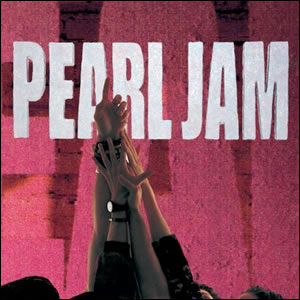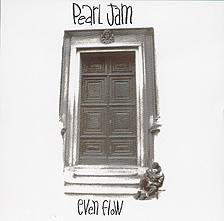Ten by Pearl Jam

 Pearl Jam‘s excellent debut is one of the most potent and indelible of debut albums ever released. The album called Ten was released in August 1991, at the vanguard of a new musical movement spearheaded by the Seattle grunge invasion. This album has sold just over ten million copies to date. More importantly, the fusion of syles and songcraft worked to forge a sound which would have immediate ripples through the hard rock world and beyond.
Pearl Jam‘s excellent debut is one of the most potent and indelible of debut albums ever released. The album called Ten was released in August 1991, at the vanguard of a new musical movement spearheaded by the Seattle grunge invasion. This album has sold just over ten million copies to date. More importantly, the fusion of syles and songcraft worked to forge a sound which would have immediate ripples through the hard rock world and beyond.
The album and the band itself came together after situations that developed rapidly in the 18 months prior to Ten‘s release. Pearl Jam’s founding members, bassist Jeff Ament and guitarist Steve Gossard, played together in the band Mother Love Bone during the late 1980s. That band’s career was cut short when, shortly before the release of the group’s debut album, vocalist Andrew Wood died of a drug overdose in 1990. Devastated, Gossard and Ament did not play together for months until they began jamming with fellow Seattle guitarist Mike McCready. Soon they recorded a few instrumental demos, which came to be known as the “Stone Gossard Demos”. These tapes were circulated in the hopes of finding a singer and drummer to complete a rock band. San Diego vocalist Eddie Vedder acquired a copy of the demo and began to write lyrics for the instrumentals. Songs originally titled “Dollar Short”, “Agytian Crave”, and “E Ballad” were soon reworked as “Alive”, “Once”, and “Black”. Gossard and Ament heard the updated demo with Vedder’s vocals and lyrics, and sent him a ticket to fly to Seattle for an audition on October 13, 1990. There Vedder rehearsed with the band, which now included drummer Dave Krusen.
The new band was initially named Mookie Blaylock after the New Jersey Nets basketball star, but because Blaylock had recently landed a deal with Nike, the band had to reconsider the name and settle on Pearl Jam, while Ten‘s title was taken from Blaylock’s jersey number. They soon landed a deal with Epic Records and entered Seattle’s London Bridge Studios in March 1991 with producer Rick Parashar. In little more than a month, the sessions were completed and soon after, in May 1991, Krusen left the band to enter rehab and was replaced by drummer Matt Chamberlain.
Vedder’s lyrics for the album are mainly negative and deal with subjects like depression, loneliness, and suicide. The song “Jeremy” was inspired, in part, by a true story in which a high school student shot himself in front of his classmates. This haunting but catchy tune includes an unconventional storytelling vocal melody during the verse and a soaring hook during the chorus. The music for the song was written on acoustic guitar by bassist Jeff Ament in February 1991, just before the band went into the studio.
Both the opener “Once” and the brilliant “Alive” were formed as part of a three song cycle by Vedder called “Mamasan” (with the third song, “Footsteps”, a B-side on the “Jeremy” single). “Alive” starts with a slow, methodical, majestic intro by Gossard, but is then dominated by Vedder with his distinct and odd vocals and melody. A simple but entertaining guitar riff in the calm bridge gives way to a contrasting coda/crescendo jam by McCready. While the song’s lyric deals with the shock of a son discovering that his real father is dead, many fans have come to interpret interpreted “Alive” as an uplifting and inspirational anthem.
 According to the band members, “Evenflow” was an extremely difficult song to record, taking up to 75 to 100 attempts to capture effectively. The result, however, is another classic, vocally driven song with a great hook during chorus and a heavy funk riff by Gossard. The song nearly fades away during the lead bridge, before coming back with a vengeance in another outtro crescendo. Vedder’s lyrics describe his experience of being a homeless man and panhandler. The song was released as the second single from Ten and peaked at #3 on the Mainstream Rock charts.
According to the band members, “Evenflow” was an extremely difficult song to record, taking up to 75 to 100 attempts to capture effectively. The result, however, is another classic, vocally driven song with a great hook during chorus and a heavy funk riff by Gossard. The song nearly fades away during the lead bridge, before coming back with a vengeance in another outtro crescendo. Vedder’s lyrics describe his experience of being a homeless man and panhandler. The song was released as the second single from Ten and peaked at #3 on the Mainstream Rock charts.
The album also includes a couple of calm, surreal, melancholy efforts that act as an excellent counter-weight to the heavier songs on the album. “Black” is a melancholy song with obscure lyrics that appear to deal with a loss of some kind. It contains a signature, harmonic vocal motif which, combined with an accompanying lead guitar, forms a memorable sonic hook in the background of the song. The acoustic and melodic “Oceans” is nearly a love song with a few odd passages and percussive effects which make it a unique ballad. “Release” is a more droning and atmospheric piece.

Ten was not an immediate success, as it initially sold slowly upon its release. It took until the later part 1992 until it finally caught on in the mainstream, peaking at #2 on the Billboard album chart. Ironically, Pearl Jam was then accused by some of “jumping on the grunge bandwagon” in the wake of the immediate success by their crosstown contemporaries Nirvana, even though that band released their breakthrough album, Nevermind in September 1991, a month later than Pearl Jam’s debut. There has been much debate over the years over which of these two albums from 1991 was the superior effort. For us at Classic Rock Review there is no contest as Ten is deeper, better sounding, with better songs and much less filler material. That is why it is our Album of the Year for 1991.
~
Part of Classic Rock Review’s celebration of 1991 albums.







November 5, 2018 @ 6:31 am
It was named TEN after Mookie Blaylock’s shirt number actually :D
November 22, 2018 @ 3:16 am
It was, indeed, named Ten after Mookie Blaylock’s shirt number, but the album ALSO does not have ten tracks:
“The 1991 album, called Ten after the number of tracks included on the album”
November 22, 2018 @ 6:54 pm
Thanks for pointing that out, we have updated the article.